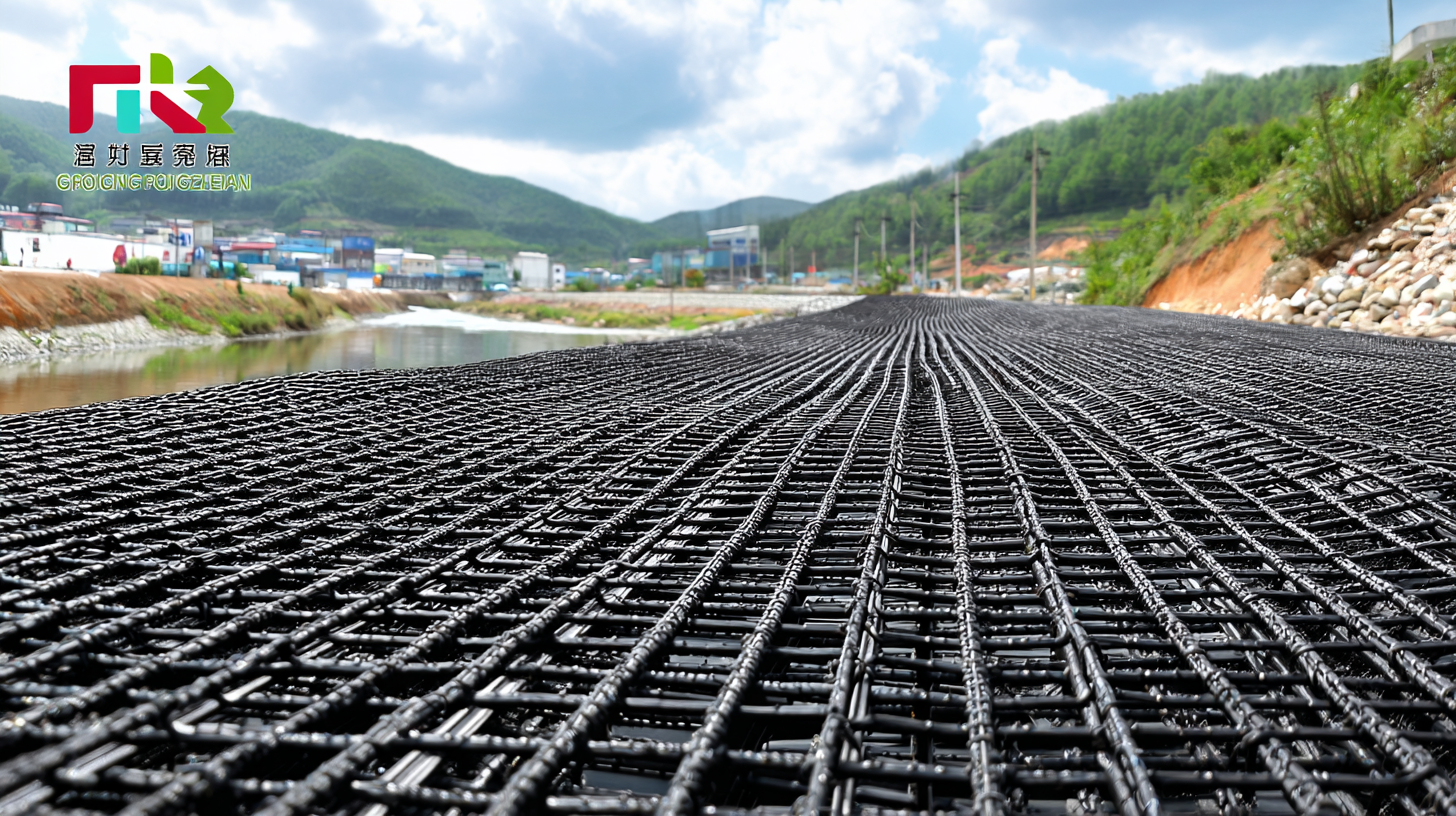Inquiry
Form loading...
- Phone
- E-mail
The Geogrid Mesh market is poised for significant growth in 2025, driven by advancements in construction technologies and infrastructure development. According to a recent report by XYZ Research, the global geosynthetics market, which includes Geogrid Mesh products, is projected to reach USD 15 billion by 2025, with a compound annual growth rate (CAGR) of 6.5%. The increasing demand for efficient soil reinforcement and improved stability in civil engineering applications is a primary factor fueling this trend.
 Additionally, innovations in materials and manufacturing processes are enhancing the performance characteristics of Geogrid Mesh, making it an indispensable solution for modern engineering challenges. As industries shift towards sustainable practices, the emphasis on durable and eco-friendly Geogrid Mesh solutions will further catalyze market expansion, positioning it as a cornerstone of future infrastructure development.
Additionally, innovations in materials and manufacturing processes are enhancing the performance characteristics of Geogrid Mesh, making it an indispensable solution for modern engineering challenges. As industries shift towards sustainable practices, the emphasis on durable and eco-friendly Geogrid Mesh solutions will further catalyze market expansion, positioning it as a cornerstone of future infrastructure development.
The geogrid mesh market is poised for significant growth in 2025, driven by a confluence of innovative technologies and increasing demand across various construction projects. One of the primary growth drivers is the rising need for sustainable infrastructure solutions. As urban areas expand and environmental regulations tighten, the adoption of geogrid mesh in soil reinforcement and stabilization is becoming essential. This material enhances the durability and strength of construction projects while minimizing soil erosion, making it a preferred choice among engineers and architects.
Furthermore, advancements in manufacturing processes are revolutionizing the geogrid mesh industry. The introduction of high-performance materials, such as polymer and composite geogrids, is opening up new applications and improving product efficiency. Additionally, developments in smart technology integration, such as sensors embedded within geogrids for real-time monitoring, are enhancing performance and paving the way for future innovations. As industries recognize the multiple benefits of these advanced geogrid solutions, including cost-effectiveness and improved structural integrity, the market is anticipated to witness substantial growth in the years ahead.
The geogrid mesh technology landscape is evolving rapidly, with significant advancements expected to shape the market by 2025. Innovations in this field are driving eco-friendly solutions and infrastructure resilience, addressing urgent sustainability demands. Recently, geogrid technology has emerged as a critical player in reducing carbon emissions in road infrastructure, showcasing how advanced materials can significantly lower maintenance costs while enhancing durability.
Industry insights suggest a substantial increase in the adoption of geogrids, especially with new applications being tested in major roadworks and innovative designs developed by leading technology institutes. For instance, the collaboration between IIT Indore and IIT Hyderabad is set to deliver sustainable geogrids that reinforce climate-resilient infrastructures. It's estimated that the geosynthetics market will witness a notable compound annual growth rate as infrastructure development accelerates globally.
**Tip:** When selecting geogrid solutions for your projects, evaluate the environmental impact alongside the technical benefits. Innovative geogrid options can notably enhance the lifespan of structures while contributing to sustainability goals.
Moreover, companies expanding their operations, such as new manufacturing plants in emerging markets, suggest a robust push towards meeting the growing demand for advanced geogrid applications. Keeping abreast of these changes will be essential for industry stakeholders looking to leverage the advantages of geogrid innovations effectively.
**Tip:** Stay informed about the latest technological breakthroughs in geogrid materials and their eco-implications. Engaging with industry research can provide valuable insights that inform your strategy and implementation choices.
This chart illustrates the projected growth of the Geogrid Mesh market from 2020 to 2025, highlighting significant increases in market size as innovations in geogrid mesh technology continue to evolve.
The regulations impacting the geogrid mesh industry are pivotal in shaping its growth trajectory. As governments increasingly focus on sustainable construction practices and environmental protection, stringent standards are being imposed on materials utilized in civil engineering projects. These regulations not only ensure safety and durability but also promote the use of innovative geogrid solutions that enhance soil stabilization and reduce environmental footprints. Companies that align their products with these evolving regulatory frameworks are likely to gain a competitive edge in the market.
Moreover, the impact of regulations extends beyond compliance; it drives a wave of innovation within the industry. With the push for higher performance standards, manufacturers are motivated to invest in research and development, resulting in advanced geogrid technologies that meet and exceed regulatory requirements. This includes the development of more effective materials that offer superior interaction with soil structures, ultimately leading to improved project outcomes. As the geogrid mesh industry navigates these regulatory landscapes, it presents opportunities for growth and technological advancement that stakeholders cannot afford to overlook.

The geogrid mesh market is poised for significant transformation as we approach 2025, driven by a combination of technological advancements and evolving industry needs. Major players like Tensar International Corporation, NAUE GmbH & Co. KG, and HUESKER Synthetic GmbH are at the forefront, investing heavily in R&D to enhance product efficacy and durability. According to a recent report by MarketsandMarkets, the global geogrid market is projected to grow from USD 1.55 billion in 2020 to USD 2.95 billion by 2025, reflecting a compound annual growth rate (CAGR) of 14.2%. This growth highlights the increasing adoption of geogrid mesh in various applications, including road construction, retaining walls, and soil reinforcement.

Competitive strategies among leading companies are focusing on innovation and sustainability. For instance, Geogrid specialists are exploring the integration of biodegradable materials in their products, appealing to environmentally-conscious consumers. Additionally, advancements in manufacturing techniques are leading to more efficient production processes. Notably, this competitive landscape is marked by strategic partnerships and expansions, which further enhance market capabilities. The collaboration between industry giants and technology firms is likely to stimulate innovative solutions that further redefine the geogrid mesh applications across infrastructure and construction projects.
Sustainability in the production and application of geogrid mesh is rapidly gaining traction as the industry evolves to meet environmental demands. Recent studies highlight that around 60% of geogrid manufacturers have adopted eco-friendly materials and processes, aligning with global sustainability goals. The integration of recycled polymers and the reduction of carbon emissions during production not only contribute to a lower environmental footprint but also enhance the overall performance of the geogrid meshes. According to a report by the Global Geosynthetics Market, the industry is expected to witness a compound annual growth rate (CAGR) of 6.2% from 2025 onward, driven in part by these sustainable practices.
Moreover, the application of geogrid mesh in construction and civil engineering projects reflects a growing emphasis on sustainable development. Innovative uses of geogrids—such as in soil stabilization and erosion control—help extend the lifespan of infrastructure while minimizing the need for new materials. Data shows that projects utilizing geogrid technology can achieve a 30% reduction in material usage, demonstrating that sustainability can go hand-in-hand with efficiency. As the geogrid mesh market continues to evolve, these sustainability practices will play a pivotal role in shaping a more responsible and innovative industry landscape.
